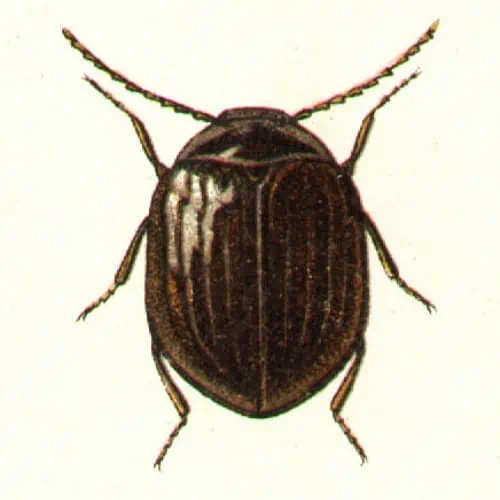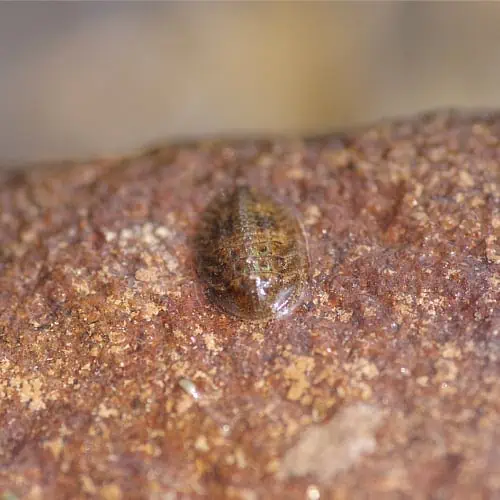Easy Drawing of Water Pennies Water Pennies Bioindicator
Water Penny Beetle Facts & Information Guide 2022 (Psephenidae spp.)

The water penny is a beetle in the Order Coleoptera and the family Psephenidae. The name "water penny" comes from the unique appearance of their larval form, which resembles a penny in shape and coloration! The majority of a water penny's life cycle exists in the aquatic larval stage, and they will live on land only during the shorter adult stage of their lives. As adults, they're sometimes known as riffle beetles. As a group, these beetles are generally solitary, though in some species, individuals have been observed in close proximity.
There are approximately 270 species of water penny distributed globally on every continent except for Antarctica. They thrive in both temperate and tropical climates, while the highest diversity of water penny species can be found in tropical Asia.
Water pennies are sensitive to changes such as pollution, high sedimentation, and an abundance of algae and fungi, so their presence acts as a bioindicator of habitat health. Where water pennies thrive, the water is likely well-oxygenated and unpolluted. Sampling for aquatic macroinvertebrate populations is becoming a popular method of monitoring freshwater habitats because it shows a general history over time of water quality, and is not just limited to momentary conditions.
WATER PENNY FACT SHEET
COMMON NAMES
Water penny, riffle beetle
SCIENTIFIC FAMILY NAME
Psephenidae
TYPE
Semi-aquatic macroinvertebrate
NATIVE HABITATS
Rocky rivers and streams
AVERAGE LIFE SPAN (IN WILD)
1-2 years
IUCN RED LIST STATUS
Most species are Least Concern
What Do Water Pennies Look Like?

These insects are most easily recognized in the larval stage. They have small, round, copper-colored bodies and are about 3-10 mm long. A term used to describe the larvae is platyform, meaning it has a flattened body. When viewed from above, the abdominal segment extends outward so that the head and legs are entirely hidden underneath.
It has a couple of adaptations that make it well suited for spending the majority of its larval life attached firmly to rocks. The legs have little claws that give it a good grip, and the plates on the abdominal segment are flexible, which help it mold to the shape of the rock. There are 5 pairs of feathered gills on its rear end that grab dissolved oxygen from the current. Both the larvae and adults can breathe air through spiracles along the abdomen.
The adults have a more typical appearance for a beetle. They are dark and shiny, have oval-shaped bodies that are slightly wider on the back end, and serrated antennae. They grow to about 4-6 mm in length.
Water Penny Habitats – Where Do They Live?

The larvae spend their time clinging to the undersides of submerged rocks in fresh flowing bodies of water – mostly rivers and streams but occasionally lakes with high wave action. Their flat body shape helps keep them from being swept away by the swift current, and has enabled them to fill a niche (flowing bodies of water) that would sweep away other aquatic insects. Their ideal habitat has a moderate level of algae – enough for their food source to be plentiful but not too much, as they are sensitive to an excess of nutrients and a thick layer of algae prevents them from grasping onto rocks.
The adults are terrestrial and spend their time around and under rocks and logs on the edges of streams. They are capable of flight, which helps them find new suitable habitats and mates.
What Do Water Pennies Eat? (Water Penny Diet)

The larvae's diet mostly consists of algae, and it uses rasps on its legs to scrape up its food. They are sensitive to light so they will spend much of their time hiding under rocks to avoid predators during the day, then will emerge at night and feed on the algae-covered rock surfaces.
There is not currently much information about the adult's diet, as adults have not been heavily studied. They may not eat at all during their short adult lifespan and instead use reserves of energy from their larval stage.
The water penny is preyed on by birds, fish, and small mammals.
Are Water Pennies Dangerous or Venomous?
Water pennies are not dangerous or venomous in either their larval or adult stage, preferring to avoid humans and just about anything else as they tend to be toward the base of the food web in ecosystems that they're found in. If found in their larval stage, water pennies are likely to just remain suctioned to their respective rock or log if disturbed, or they'll detach and swim away. Adults will walk or fly away in most cases, and aren't known to bite. They're quite a beloved species to observe for both children and adults alike!
Not only are water pennies not harmful, but they're actually beneficial! They feed primarily on algae and detritus, helping to control algae growth and reduce the buildup of dead organic matter. Additionally, they're not tolerant of pollution or low-oxygen conditions, meaning that they're often indicators of healthy water quality where they're found! However, if they are absent in a freshwater ecosystem, it doesn't necessarily indicate poor water quality. Water pennies also provide a valuable food source for fish, such as bass and trout.
The Life Cycle of Water Pennies

Just like other beetles, water pennies go through a complete metamorphosis. The female will generally dive underwater to lay her eggs amongst algae-covered rocks, which the larvae will suction cup themselves to as soon as they hatch. They have also been known to lay eggs above the water's surface, allowing the water to whisk the larvae away to suitable habitat.
The larvae can take over a year to mature and goes through two stages – the first is the true larval stage and can last nearly two years before changing into pupae. They will even overwinter in colder climates and then pupate the next year if they didn't grow large enough during the warm season. Most individuals will leave the water to pupate in moist soil, but they can also make an air-filled chamber to pupate in the water.
After pupating for 10-30 days, the water penny emerges as an adult. Once it reaches adult form, its sole mission is to reproduce, living for anywhere from a few days to a few weeks – just long enough to find a mate and, if female, lay hundreds of thousands of eggs.
How to Attract Water Pennies to Ponds? Are They Beneficial?
As discussed in the introduction, water pennies can be used as a bioindicator of water quality and will thrive in clean bodies of water with low sedimentation. They also require high oxygen content, so ponds with running water in a stream or fountain setup are the most likely to attract them. Because the adults fly to find new areas suitable to lay their eggs, larva may spontaneously appear if conditions are met.
As mentioned above, water pennies feed on algae and decaying matter, thus aiding in nutrient cycling. Additionally, they provide a valuable food source for fish, birds, and some small mammals willing to search for them, such as raccoons.
Source: https://pondinformer.com/water-penny-beetle-psephenidae/
0 Response to "Easy Drawing of Water Pennies Water Pennies Bioindicator"
Post a Comment